Brent’s close to $65 a barrel and WTI is climbing closer and closer to $60—and analysts are rushing to make bullish forecasts for the fourth quarter of the year. Big Oil is preparing for an even better three-month period than Q3, when all supermajors beat profit expectations. Two of them stand out: Exxon and Shell.
It’s no secret that Shell has ambitions to overtake Exxon as the world’s number-one oil company in terms of value. It’s actually on track to beat Exxon on cash flow from operations for full 2017. The Anglo-Dutch company is also considering a share buyback at some point in the future as financial performance improves and the company gains confidence that it can cover dividend payouts with cash on hand.
Meanwhile, Exxon, according to some analysts, is stretching itself thinner and thinner in order to keep its dividend payout ratio at 100 percent, as it has throughout the oil price crisis. The reliability of dividends is vital for oil supermajors since they’re the top reason investors favor the industry these days. Yet, the oil price crash created another vector for Big Oil’s dividend reliability in addition to oil prices, booked reserves, and production.
This vector is diversification, as it’s becoming increasingly clear that even if Exxon doesn’t feel threatened by electric cars, they may have another threat to consider. There is also climate change legislation, which, if implemented without delays, will seriously undercut the demand for fuels that constitutes Big Oil’s main revenue stream.
Right now, when it comes to diversification of revenue streams, Shell is a step ahead of Exxon. The Anglo-Dutch supermajor recently bought Europe’s biggest EV charging network, NewMotion. It also has plans to double its chemicals business size by 2025, betting big on shale gas. Part of its new planned capacity is a $10 billion petrochemicals complex in the Marcellus shale. Related: Can Iraq Dethrone Saudi Arabia In This Crucial Oil Market?
Shell’s ambitions don’t stop there. It will spend $1 billion annually on green energy projects until 2020, and plans to derive a fifth of its global fuel station sales from EV recharging and low-carbon fuels. That’s in addition to its shift to gas following the acquisition of BG Group two years ago.
Meanwhile, Exxon is also spending $1 billion annually on cleaner energy projects, but its focus in predominantly on biofuels and on projects whose commercialization lies far in the future. It is pursuing its core business as it has for decades: expanding in the shale patch. It also recently entered Brazil’s deepwater offshore zone with a $1.2-billion bid for 10 oil blocks at an auction.
At the same time, Exxon is growing its petrochemicals production capacity as well. The latest piece of news in this respect was the announcement of a major investment in a petrochemical complex in China. Exxon seems to be a strong believer that petrochemicals and diesel demand from heavy-duty machinery will completely offset any increase in EV adoption. In fact, Vice President Jeff Woodbury recently said Exxon had no problem with EVs, which, according to a company forecast, would only represent 6 percent of the global passenger car fleet in 2040. Exxon won’t have a problem even if gasoline demand ended some day, it will just produce more diesel, Woodbury said. Related: Can Oil Prices Hit $65 This Week?
However, research is happening in the field of electric trucks as well. Tesla is set to unveil its Semi later this month. Maritime vessels are switching to LNG. Nickel and cobalt demand is rising fast, indicating a rather bullish outlook for EVs, contrary to Exxon’s skepticism. In fact, Daimler, which showcased an electric truck at the end of October, believes we’re just two years away from electric trucks that can sell for the same price as diesel vehicles, thanks to the quick drop in battery prices.
Can petrochemicals alone drive Exxon’s profits up in the near-to-long term? We’ll have to wait and see, but in the current industry context and global trends in energy demand, Shell’s bet on gas and EVs in addition to chemicals and oil seems a safer one than sticking to the core business.
By Irina Slav for Oilprice.com
More Top Reads From Oilprice.com:
- What A U.S. Electric Grid Attack Looks Like
- Oil Rally Halts As Saudi Purge Continues
- Shell Gears Up For Peak Gasoline


















